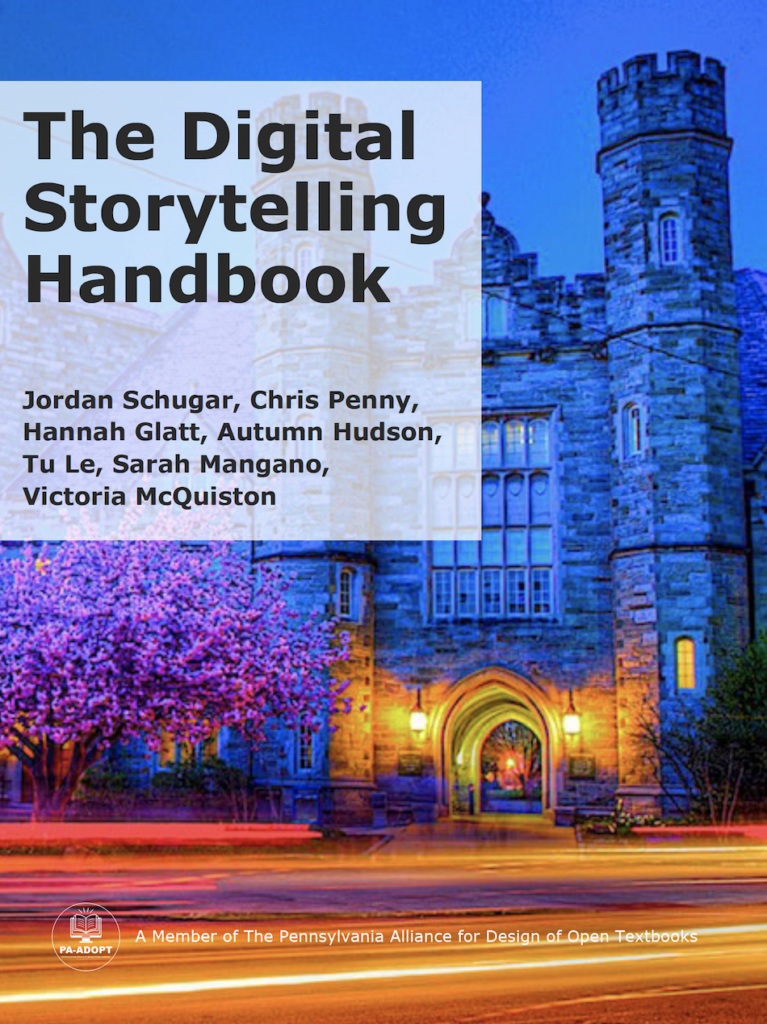The Digital Storytelling Handbook
by Jordan Schugar & Chris Penny
Hannah Glatt, Autumn Hudson, Tu Le,
Sarah Mangano, Victoria McQuiston
Keywords: Literacy, Multimedia, Mobile Pedagogy, Humanities, Rhetoric and Composition

About the Book
The Digital Storytelling Handbook is designed to provide an introduction to digital storytelling and its multifaceted applications in the higher education classroom space. This eTextbook gives storytellers practical tools to help them think about different reasons for making digital stories and different ways to think about using and incorporating digital stories into teaching, learning, and living. In this eTextbook, readers will also learn how experiencing digital stories — as either the author or the audience — builds cultural competence and teaches us about humanity and the human experience. Co-authored with students, this eTextbook was written in the spirit of OER with the expectation that future readers and students have an opportunity to contribute a chapter, idea, approach, or methodology of the eTextbook’s basic content.
Chapters
- Before the Beginning
- Setting the Stage
- Using What You Have
- Process of Digital Storytelling
- Why Use Digital Storytelling?
- Building Cultural Competence with Storytelling
- Strategies for Digital Stories
- Video Interviews
- Storytelling Using Emotion
- Storytelling Through Visual Aids (Photography and Videography)
- Short Films
- Six Words, Six Shots Video Story
- Documentary
- Color’s Impart on Digital Storytelling
- Conclusion
- Appendix
General Information
- Publication Year: 2024
- Edition: First
- Subject: Educational Technology and Digital Literacy
- Latest File Update: December 3, 2025
License

This work is licensed under a Creative Commons Attribution-NonCommercial 4.0 International License (CC BY-NC 4.0) as a part of PA-ADOPT, except where otherwise noted.
Usage
Readers
The eTextbooks created as a part of this program are provided in two formats: ePub and PDF. Please refer to our Reader Support section for guidance on which format may be best for you and the device(s) you use.
Instructors
If you are an instructor seeking to use this eTextbook in your own course(s) please feel free to download the ePub and/or PDF file(s) for your use, but make sure to complete our eTextbook Usage Survey (this information is used for program evaluation purposes).
If you are interested in making revisions and edits to this eTextbook please note that this is possible since the book is under a Creative Commons License, which allows you to remix, reuse, revise, and redistribute the eTextbook. Please refer to the Faculty Support Page, specifically looking at Remixing. You can download The Digital Storytelling Handbook Apple Pages File in order to use the original document to revise and remix the eTextbook for your purposes.
Citations
MLA: Schugar, Jordan, Chris Penny, Hannah Glatt, Autumn Hudson, Tu Le, Sarah Mangano, and Victoria McQuiston. The Digital Storytelling Handbook. First, The Pennsylvania Alliance for Design of Open Textbooks (PA-ADOPT), 2024.
APA: Schugar, J., Penny, C., Glatt, H., Hudson, A., Le, T., Mangano, S., & McQuiston, V. (2024). The Digital Storytelling Handbook (First). The Pennsylvania Alliance for Design of Open Textbooks (PA-ADOPT).
Chicago: Schugar, Jordan, Chris Penny, Hannah Glatt, Autumn Hudson, Tu Le, Sarah Mangano, and Victoria McQuiston. The Digital Storytelling Handbook. First. The Pennsylvania Alliance for Design of Open Textbooks (PA-ADOPT), 2024.
Peer Review
This eTextbook went through an Open Peer Review process. The peer review process used the Open SUNY Textbook Peer Review Guidelines, allowing peer reviewers to read the text carefully and evaluate the following:
- Educational Significance of Content including accuracy, appropriate and useful materials, valid and significant concepts, models, and skills, and key elements;
- Effectiveness as a Teaching Resource including a clear explanation of the concepts, alignment of materials to the learning process of the target audience, and alignment of the learning objectives with course goals; and
- Readability and Ease of Use including clarity and comprehensiveness, consistent writing style, readability and ease of use (logic, sequence, and flow), appropriateness for target readership level, and quality of Interactivity and multimedia learning objects.
As a part of the open peer review process, the public review conducted by Dr. Laquana Cooke is made available: Peer Review Document (PDF).